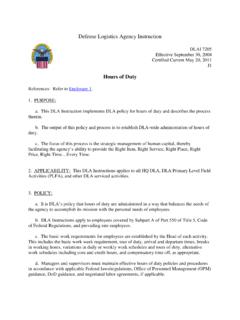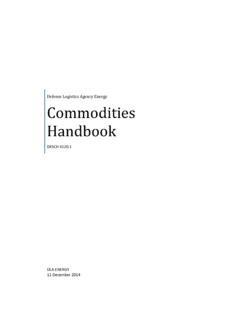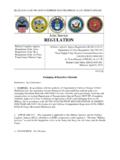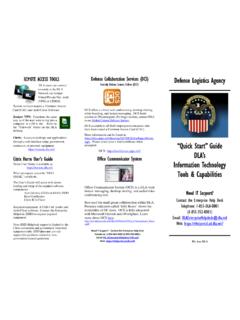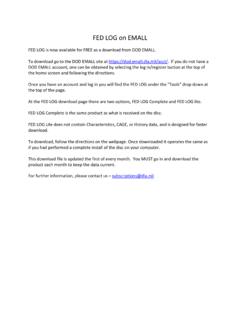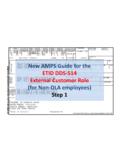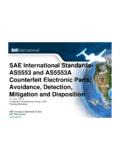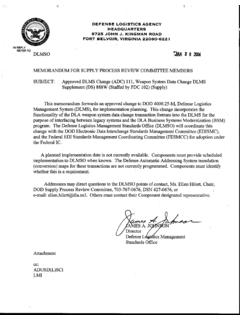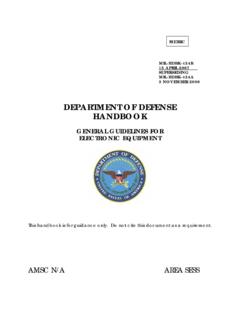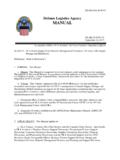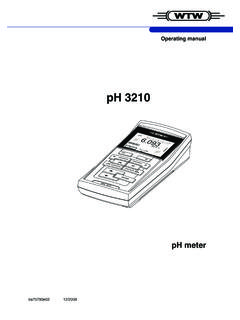Transcription of APROVED DLMS CHANGE (ADC) 233 - Defense Logistics …
1 APROVED dlms CHANGE (ADC) 233. New dlms Information Exchange for Tracking Non-Ready-For-Issue (NRFI) Carcass Returns 1. ORIGINATOR: a. Service/Agency: Navy, NAVSUP and Naval Supply Information Systems Activity (NAVSISA). b. Originator: NAVSUP 421, DSN: 430-7510, Commercial 717-605-7510. 2. FUNCTIONAL AREA: Supply (Intra-Navy/USMC). 3. REQUESTED CHANGE : a. Title: New dlms Information Exchange for Tracking NRFI Carcass Returns b. Description of CHANGE : The purpose of this CHANGE is to map the Navy's current unique transactions to a new dlms transaction identified as dlms Supplement 856C for use in the Navy procedures associated with carcass tracking of depot-level reparables (DLR). Navy is currently using a combination of Electronic Data Interchange (EDI) X12 transactions and internal Navy-unique BK_ - Series transactions to accomplish. This CHANGE will support the Navy migration to dlms and allow for future enhancements such as item unique item identification (IUID).
2 C. Background: (1) The Navy uses the DLR Carcass Tracking System to provide inventory managers the means to monitor the flow of NRFI reparables from end users through the retrograde pipeline and repair cycle and then subsequent return to supply system stock. When activities have requisitioned DLRs using intra-Navy reparable item advice codes (Advice Codes 5G, 5R, 5S, 5V, 5Y, 52 or 56), they are required to return a NRFI carcass to the supply system. When the ICP receives notice that a DLR was issued, an outstanding carcass file is annotated. Until a transaction item report (TIR) is received indicating carcass receipt, the ICP keeps the file open and continues searching for the asset. Lack of a valid proof of shipment may result in carcass charges back to the requisitioner. NAVSUP Publication 485, Volume 1, paragraphs 8330 8339. contains specific steps and procedures regarding the DLR Carcass Tracking System.
3 (2) The Fleet Automated Control Tracking System (FACTS) is used by afloat activities to facilitate turn-in of their retrograde material and to provide visibility from the point of turn-in by the end user through receipt into the Advanced Tracking and Control (ATAC) hub. FACTS uses several EDI transactions to notify NAVICP of the turn-in, to report the shipment of the retrograde material by the shipper, and to report the receipt/transshipment of the retrograde material by the intermediate transshipping activity. d. Procedures: (1) This process currently employs the following EDI transactions: (a) IC 527 Material Due-In and Receipt. This transaction is used in place of the Navy-unique D6R transaction. (b) IC 856S Shipment Notice/Manifest. This transaction is used in place of the hard copy DD Form 1348-1A, and serves as the proof of shipment. (c) IC 861 Receiving Advice/Acceptance Certificate.
4 This transaction serves as the receipt at a transshipping point and is a Navy-unique 861 format. (2) In addition, this process employs the following intra-Navy unique 80 record position transactions: (a) BK1 Follow up on Shipment of Non-RFI Carcass: The BK1 transaction is sent by the ICP to the shipping unit when the carcass is not received within the established timeframes. (b) BK2 Response to BK1 Followup: The BK2 is sent as a response to the BK1 and will contain information such as: The location where a carcass was shipped Response Code Turn-in document number if different from the original requisition Date shipped (c) BK3 Notice of Additional Billing: This transaction is used by NAVICP. when a BK2 response is not received from an activity within the allowable timeframes or when a BK2 is received indicating no turn-in will be made. This transaction notifies the activity that the difference between the net and standard price will be billed.
5 A reason code is provided in the BK3 transaction. (d) BK4 Notice of Reduced Billing: This transaction is used by NAVICP to notify an activity that their account will be credited by the difference between the net and standard price. The BK4 will reverse a billing which resulted from a lack of, or invalid response to a carcass followup (BK2). This reversal will occur only when the customer responds or turns in a carcass after the date that a BK2 response was due and only when the late response/turn-in is accepted. (e) BKA Accepted Follow-Up Response (for BK2): This transaction is the follow-up response which indicates that a BK2 was accepted. (f) BKD Accepted Follow-Up Response (for EDI 527/D6R): This transaction is used to indicate that the Navy-unique 527/D6R was processed by the ICP. (g) BKR Rejected Follow-Up Response: This transaction is sent by NAVICP to the submitting activity to indicate that the BK2 response was rejected.
6 A reason code is provided. (h) BK5 Follow up on Transshipment: This follow-up transaction is sent to the TAC hub 30 days after NAVICP receives notification of a turn-in being shipped to the ATAC hub. (i) BK6 Response from Trans-shipping Activity: This transaction serves as the response to the BK5 Follow-Up on Trans-shipment transaction described above. A BK6. from the ATAC hub with a negative response or no response will result in the asset becoming a loss. e. Reason for CHANGE : The purpose of this CHANGE is to become dlms compliant in accordance with both the DOD ( and ) and the J-673 Memorandum for Supply and Finance Process Review Committee Members, November 7, 2001. Migration to the dlms will support enhancements such as item unique identification. 4. ADVANTAGES AND DISADVANTAGES: a. Advantages: The Navy uses these transactions to provide inventory managers the means to monitor the flow of NRFI reparables from end users through the retrograde pipeline and repair cycle and then subsequent return to supply system stock.
7 The standardization of these transactions will facilitate data sharing within Navy systems, and external to Navy, if applicable. b. Disadvantages: This requires a substantial investment on the part of the Navy and return on investment is unclear. 5. ALTERNATIVE(S): Alternative mapping of the Navy BK_ series transactions to the existing Implementation Convention 856S was considered; however, the additional content would make the transaction complex and confusing. Use of the 856C will maintain the integrity of the 856S as already established in dlms . 6. IMPACT: a. Procedures: (1) Update the dlms manual to provide high level procedures and a cross-reference to Navy guidance as shown in Enclosure 1. (2) Establish a new dlms 856C transaction (Federal IC and corresponding dlms . Supplement), specifically for carcass tracking (available on the dlms Supplement page of the DLMSO web).
8 MILS formatted BK_ series transaction layouts and mapping to the DS 856C are provided at Enclosure 2. This process is used by the Navy and some Marine Corps sites. (3) Intra-Navy code lists are provided at Enclosure 3. b. Publications: DS 856C, Not-Ready-For-Issue Carcass Tracking, ASC X12, 4030. Version, and dlms Manual. Navy publications as applicable. c. Translation: NAVSUP has responsibility for translating BK_ series transactions for NAVSUP legacy owned applications not targeted for retirement prior to 2012. NAVSUP legacy owned applications represent a small subset of Navy applications; and, therefore, it is likely that other Navy customers may request/require the translation services at DAASC. Enclosures Enclosure 1 dlms Manual DOD VOLUME 2. C23. CHAPTER 23. CARCASS TRACKING PROCESS. General Purpose. The following chapter describes a Navy unique carcass tracking process which is being migrated to the dlms .
9 This will facilitate modernization and support the addition of item unique identification within the tracking process. This chapter provides a summary overview;. refer to NAVSUP Publication 485 Volume 1 Afloat Supply, Section III, paragraphs 8330 through 8339 for specific steps and procedures for depot level repairable (DLR) carcass tracking. Applicability. This chapter is applicable to the Navy and participating USMC. activities. The dlms formats are available for adoption by any Component with a similar process. Procedures The Navy uses the DLR Carcass Tracking System to enable inventory managers to monitor the flow of Not Ready for Issue (NRFI) repairables from end-users through the Retrograde Pipeline, repair cycle and subsequent return to supply system stock. Activities are required to return a NRFI carcass to the supply system when a DLR item is requisitioned using Advice Codes 5G, 5R, 5S, 5V, 5Y, 52 or 56.
10 When the Inventory Control Point (ICP) receives notice that a DLR was issued, an outstanding carcass file is annotated. Until a transaction item report (TIR) is received indicating the carcass was received, the ICP keeps the file open and continues searching for the asset. Lack of a valid proof of shipment may result in carcass charges back to the requisitioner. The Fleet Automated and Tracking System (FACTS) is used by afloat and selected shore activities to facilitate the turn-in of retrograde material and provides visibility from the point of turn-in by the end user through receipt in to the Advance Traceability and Control (ATAC) hub. The FACTS process uses several Navy-unique EDI transactions and Navy unique BK_ transactions. The three Navy-unique EDI transactions associated with FACTS are: 1. EDI 527/D6R is the Material Due-In and Receipt transaction, provides Turn-in Notification.
